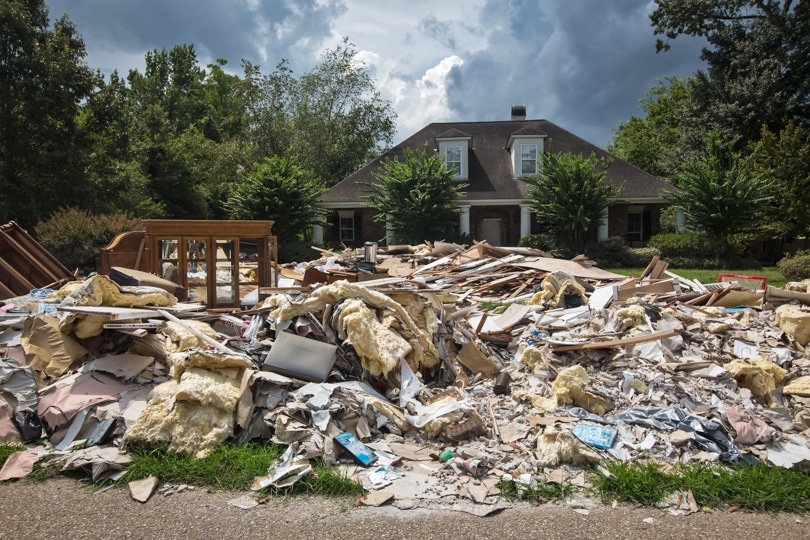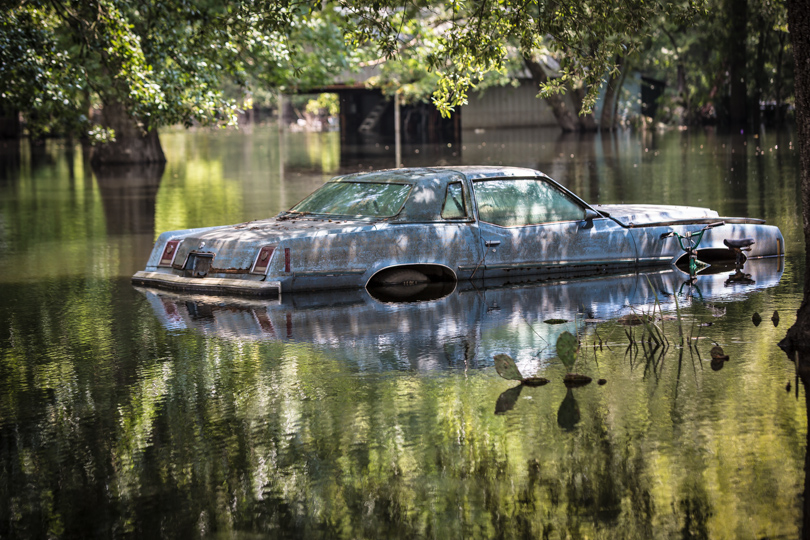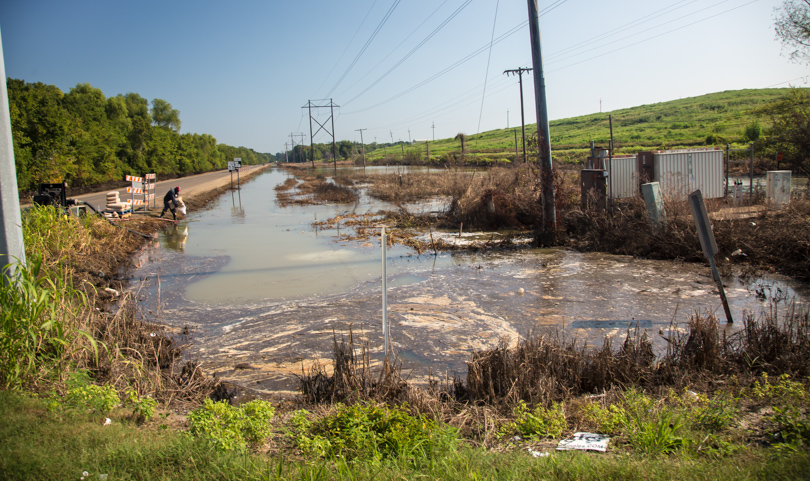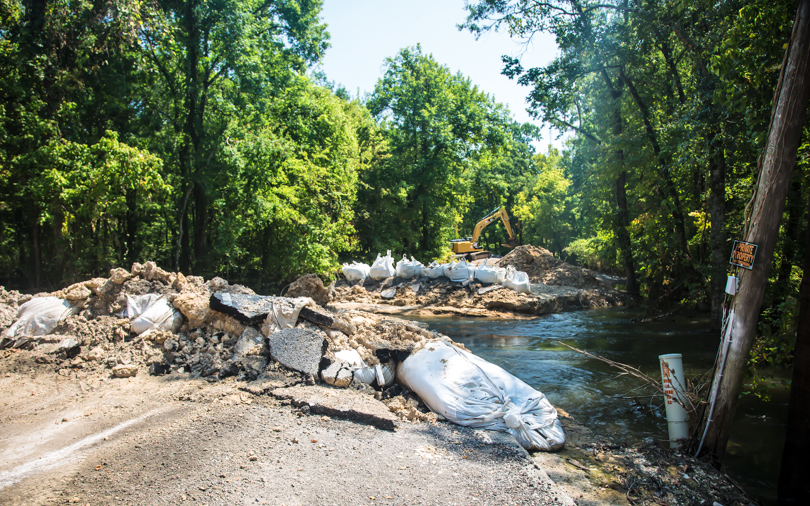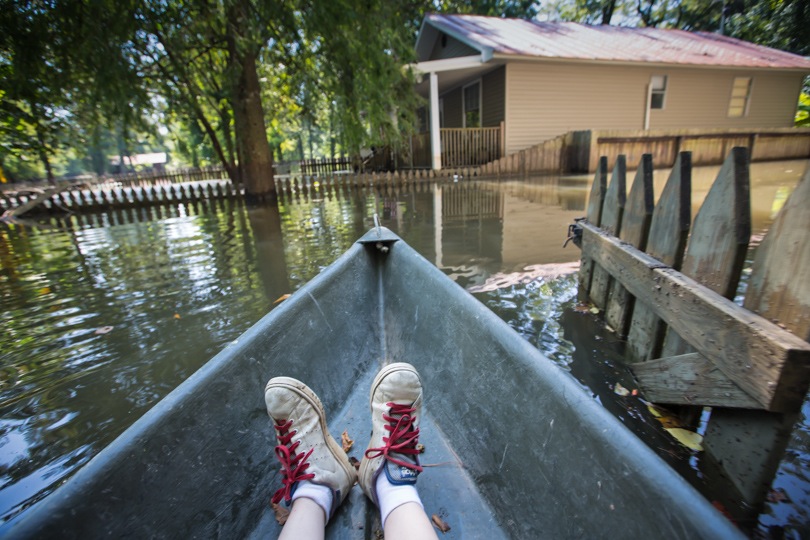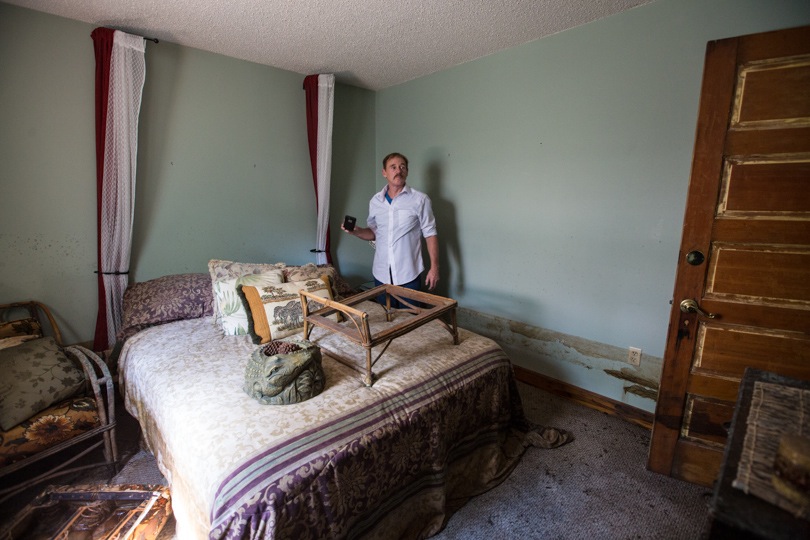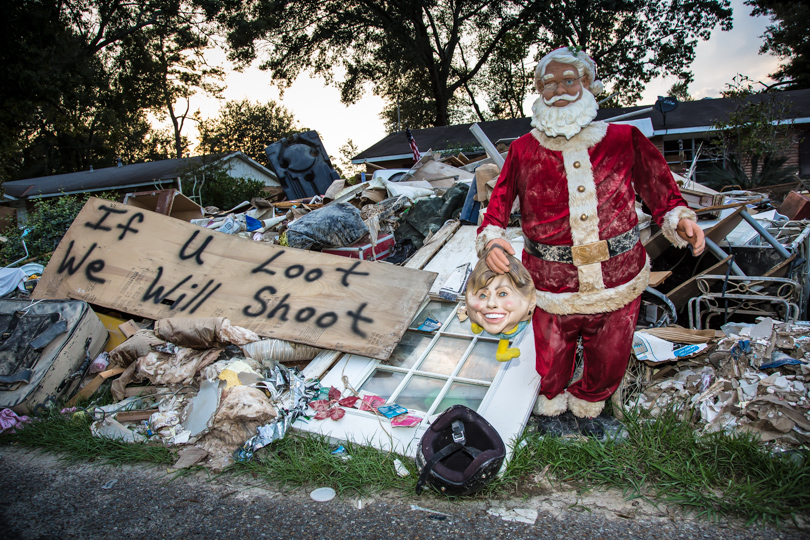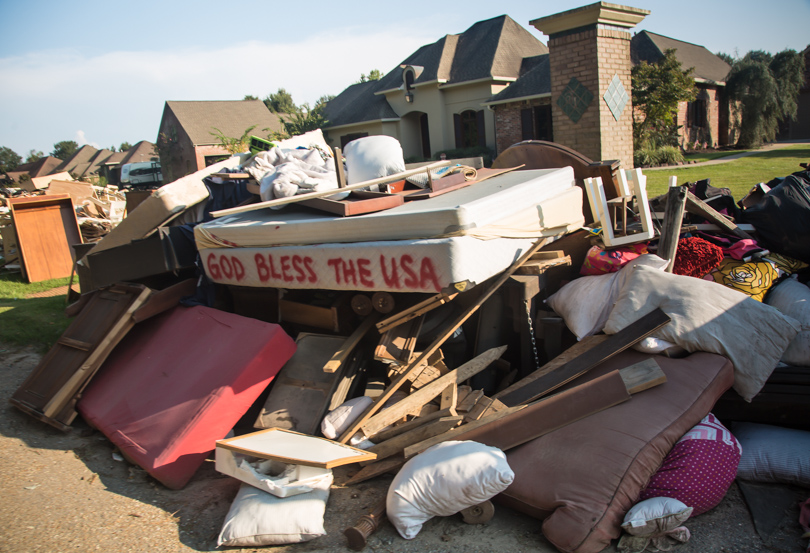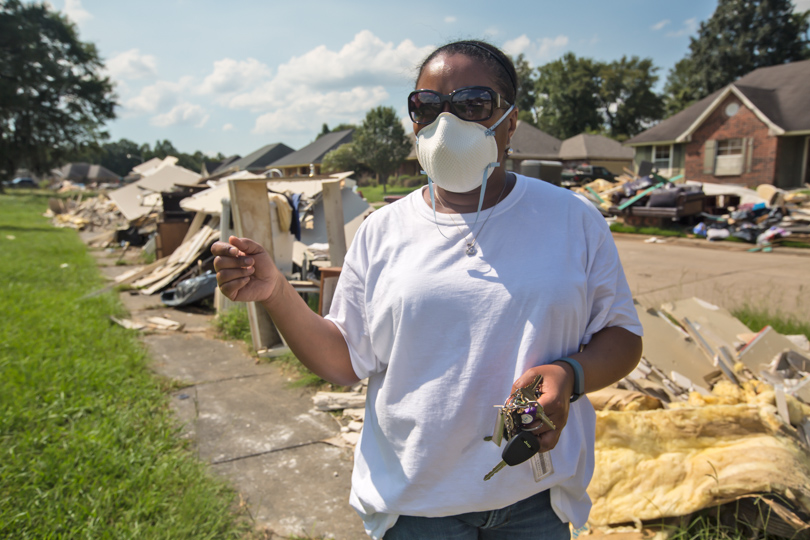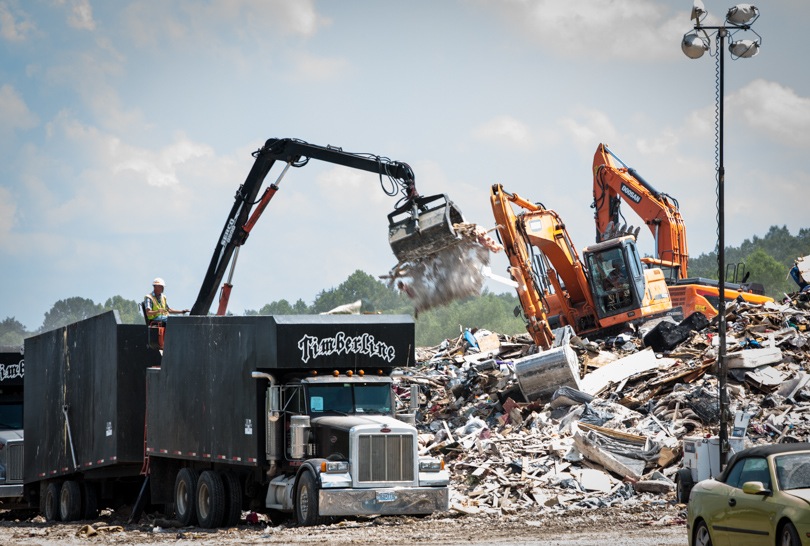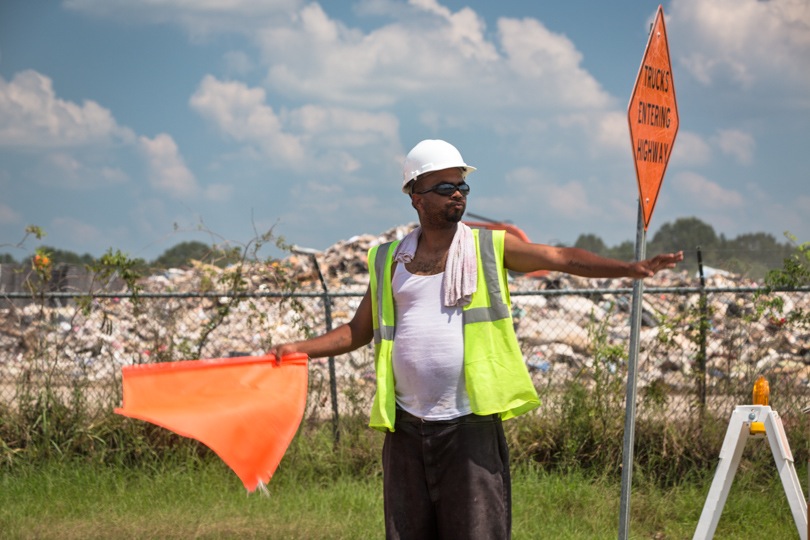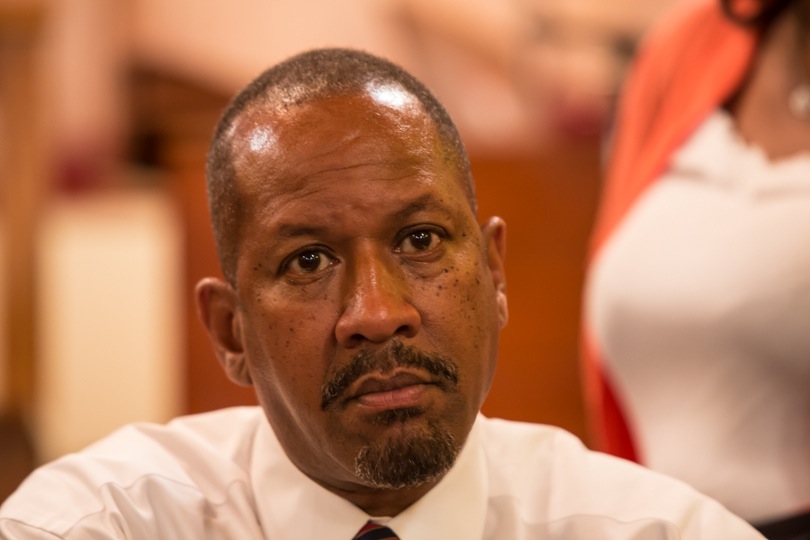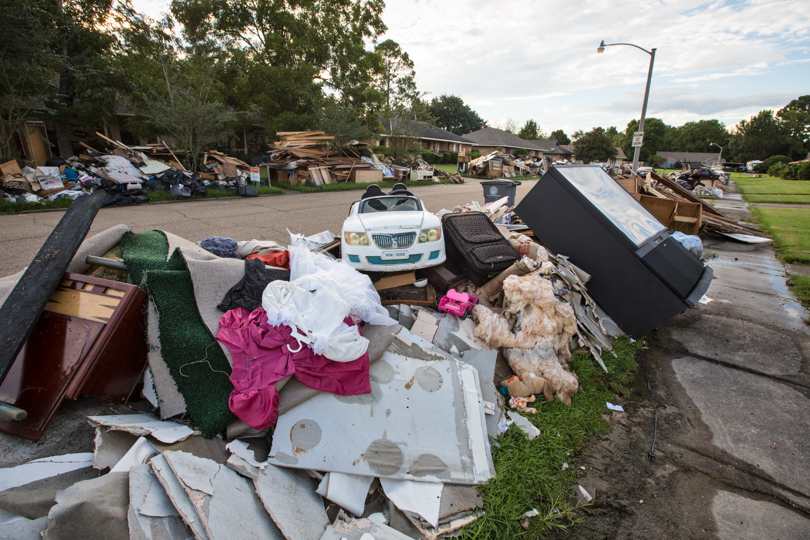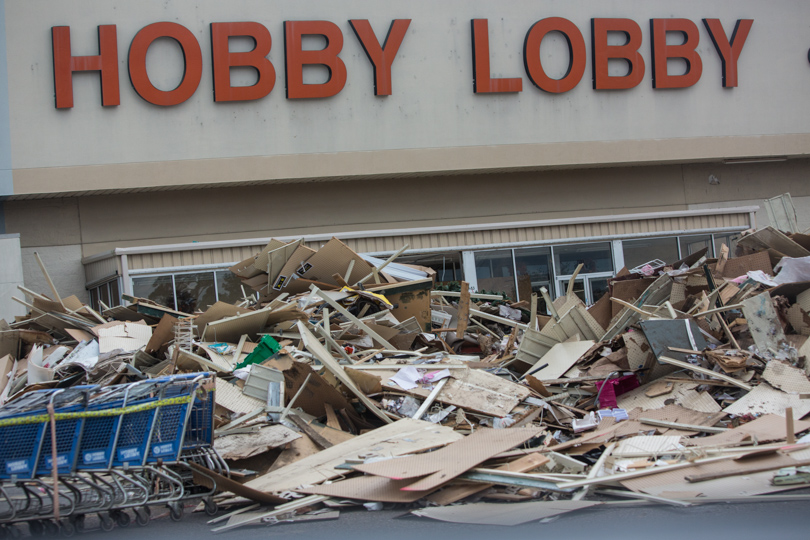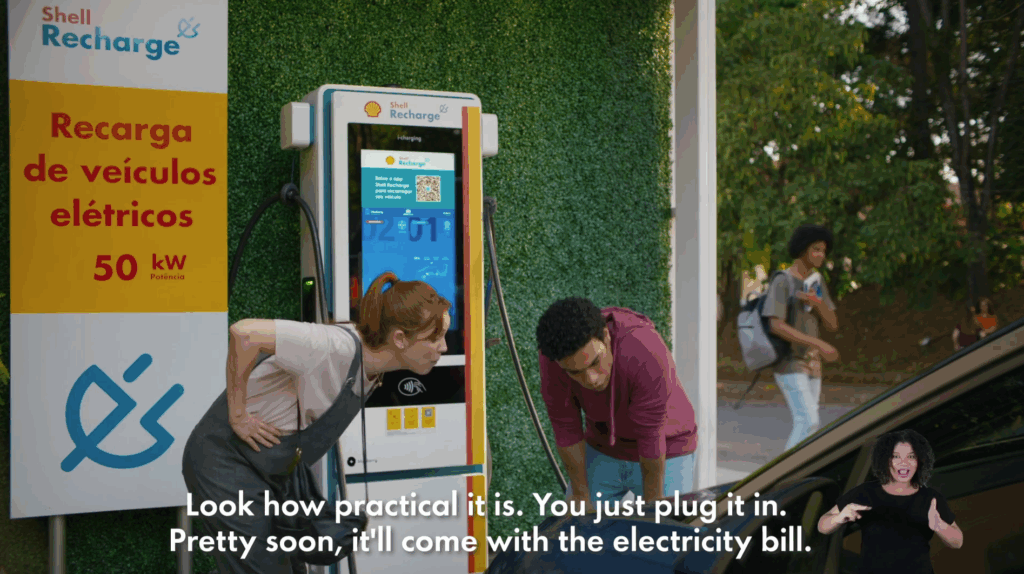In the aftermath of the 1000-year flood that hit southern Louisiana in August, environmental and public health concerns are mounting as the waters recede.
Residents want to know why many areas that never flooded before were left in ruin this time, raising questions about the role water management played in potentially exacerbating the flood. The smell of mold lingers on streets where the contents from flooded homes and businesses are stacked in piles along the curbside, as well as in neighborhoods next to landfills where storm debris is taken.
Polluted Floodwaters
I met up with Frank Bonifay whose home and business are in the Spanish Lake Basin region, about 20 miles south of Baton Rouge. We went to his home on Alligator Bayou Road, which for weeks after the flood was only accessible by boat.
Car in front of flooded home off Ridge Road in Ascension Parish, Louisiana, on September 2. ©2016 Julie Dermansky
On our way we drove past the Honeywell Geismar chemical plant near Saint Gabriel, where workers were dumping soda ash into standing floodwater next to the plant. The Louisiana Department of Environmental Quality (LDEQ) explained via email that the workers were adding soda ash to the water and circulating it with pumps to raise the pH following a release of sulfuric acid and oleum that occurred during an August 13 rainstorm.
“Anything stirred up by the flood in the industrial corridor is ultimately going to end up at my land,“ Bonifay told me. It angered him that the LDEQ didn’t inform residents with property nearby like himself.
“All of the run-off from the petrochemical companies in the area is in these waters,” Bonifay said. He warned local officials that such flooding was inevitable if the state didn’t address water management issues resulting from its continued permitting of new subdivisions and strip malls that replaced marshland in the greater Baton Rouge area.
Worker dumping soda ash in contaminated floodwater next to the Honeywell chemical plant in Geismar, Louisiana. ©2016 Julie Dermansky
LDEQ doesn’t think the chemicals that spilled at the Honeywell site present a threat to nearby residents like Bonifay because the chemicals would have dissipated when they came in contact with the floodwater.
But environmental scientist and community advocate Wilma Subra argues that though the chemicals would dissipate the residue from the Honeywell spill and other contaminants released from septic systems in the region do pose a threat to everything that they come in contact with.
Local officials made a cut in Alligator Bayou Road so floodwater could escape from the Spanish Lake Basin in southern Louisiana. ©2016 Julie Dermansky
Bonifay and I had to walk the last two miles of Alligator Bayou because it was blocked off near the cuts in the road that parish officials made to give the standing water a way to escape. On the way to his canoe, we passed numerous drowned animals. Then we paddled through stagnant water to check on his house.
Because of the standing water, he had been unable to remove the contents and gut his house, which was already full of mold.
Frank Bonifay’s flooded property about 20 miles south of Baton Rouge, Louisiana. ©2016 Julie Dermansky
Frank Bonifay checks out the damage in his flooded house. ©2016 Julie Dermansky
Storm Debris and Forgotten Lessons From Katrina
After my trip with Frank, I drove through Baton Rouge and communities to the east, including Denham Springs and Walker, Louisiana, where damage from the flood was extreme. Over the next three weeks, I photographed some of the piles of debris being removed and the mountains of debris that still remained.
A sign reminiscent of Hurricane Katrina warns potential looters to stay away from the storm-damaged belongings of a flooded home in Denham Springs, Louisiana. ©2016 Julie Dermansky
Belongings left outside flooded homes lined the streets of Walker, Louisiana, on September 2. ©2016 Julie Dermansky
Robin Kay in front of her flood-damaged home in Monticello, Louisiana. She thinks the recently completed Central Thruway roadway project contributed to the severity of the flood. ©2016 Julie Dermansky
DRC Emergency Services, the contractor charged with removing debris in Baton Rouge, expects it could take until the end of October to complete. The company has quadrupled its estimate of flood debris to 1.3 million cubic yards, according to the Baton Rouge Advocate.
When it comes to debris removal, we are doing the same stuff wrong we did after Hurricane Katrina in 2005, Subra told me. “We are still not providing the workers with the proper protection,” she said. “Respirators are needed to protect them from particulates.”
After Katrina, officials were supposed to develop contingency plans to direct the disposal of hurricane debris, so it wouldn’t end up next to residential areas again. But that is exactly what is happening: After August’s flood, LDEQ permitted a temporary landfill next to Monticello — a predominantly African-American neighborhood in east Baton Rouge, where Katrina debris was dumped 11 years earlier.
The Ronaldson Field landfill in Alsen, another African-American neighborhood just north of Baton Rouge has also been permitted to take storm debris following the storm,much to the frustration of its residents. Alsen residents have been against the private landfill since it started operations over 20 years ago.
People living next to the landfills “should be concerned,” Subra said. “The particulates that you would inhale go deep into the lungs and could contain a whole host of bacteria. Asbestos is a huge issue, and sheetrock that starts to degrade lets off hydrogen sulfide, which endangers your lungs.”
I contacted the U.S. Occupational Safety and Health Administration (OHSA) to find out about its role in protecting workers in a flood zone. Juan Rodriguez, responsible for public relations at the OHSA Dallas office, told me it has a team on the ground in Louisiana.
The team “provided information to workers, employers, and the public in general,” Rodriguez wrote in an email, though he didn’t specify where exactly the team went or what it had done.
Temporary landfill on North Sherwood Forest Drive close to Monticello, in east Baton Rouge, Louisiana. ©2016 Julie Dermansky
Naquille Everson directing traffic in front of the landfill on North Sherwood Forest Drive near Monticello, Louisiana. ©2016 Julie Dermansky
Naquille Everson, a temporary worker hired to direct traffic at the temporary landfill near Monticello, told me he was worried about breathing in mold but that no one at the landfill was wearing a respirator. He was unaware that OHSA’s website directs people to “use hand, eye, and respiratory protection“ and that “a N-95 respirator is recommended.”
Dealing with Pollution, Loss, and Landfills
At a community meeting in Alsen on September 6, residents voiced their concerns about the Ronaldson Field landfill being allowed to receive mold-covered storm debris so close to their homes.
“We have had to deal with the landfill for over 20 years,” Moses Evans, Jr. said at the meeting. He and the other Alsen residents expressed outrage that the LDEQ would let the Ronaldson Field landfill take the storm debris. Evans complained that residents had already been subjected to the landfill for much longer than the original seven years the community was told the landfill would be permitted to operate.
“This community is not fit for human beings to live already,“ Evans said. “And now the air and traffic is even worse.”
He thinks the only solution for protecting residents is for them to receive a buy-out and relocate. Many at the meeting shared this sentiment with the panel of invited guests that included Mark Stafford, the vice president of DRC Emergency Services; Sid Brian, owner of Ronaldson Field landfill; Chuck Carr Brown, secretary of the Louisiana Department of Environmental Quality; and William Patrick, Sr., public works operations manager for the city-parish.
Chuck Carr Brown, Secretary of the Louisiana Department of Environmental Quality, at the Alsen community meeting. ©2016 Julie Dermansky
Brown tried to assure the community that LDEQ is making sure no hazardous materials make it to the landfill, which is was only permitted to take construction and demolition waste. “The only thing different for this particular emergency is that now the landfill can take furniture and carpet, too,” he said.
Brown acknowledged that he couldn’t guarantee that 100 percent of hazardous waste and other items aren’t getting dumped at Ronaldson Field and reminded people that LDEQ sent out an advisory telling people to sort out hazardous waste when clearing out their homes.
The panelists insisted they were being diligent in making sure whatever household hazardous waste not separated out on curbs is pulled by workers hired as spotters. Such declarations were met with groans and laughter from the audience. People pointed out that isn’t what they are seeing when they drive around Baton Rouge.
Clearing the Air on Air Quality
Alsen resident James Tate asked if the air quality was being monitored. Brown assured him it was, but couldn’t tell him what it was being monitored for.
After the meeting, I tried to get more specifics from LDEQ public relations representative Gregory Langley about what kind of air monitoring is being done at the temporary landfills and at Ronaldson Field. He wrote to me that they “don’t have site-specific data, but we are trying to develop a protocol that will let us monitor for things the area residents are concerned about.”
He added that “LDEQ has two air monitors near the North Landfill and Ronaldson Field that can provide historical data about air quality (ozone, particulate matter, and some other pollutants, depending on the monitor) in North Baton Rouge.” However, Langley didn’t mention any air quality monitoring being done at the temporary landfill next to Monticello.
When asked why the Ronaldson Field landfill was being used to accept storm debris, DRC Emergency Services’ Stafford explained it was the only landfill DRC was able to make a deal with on short notice. Residents were skeptical of his explanation, and voiced opinions that the decision was only about profit. Evans asked Stafford and Ronaldson Field owner Brian how much money they were making, but did not receive an answer.
“There needs to be careful thought about where debris is put after such a historic flood,” Marylee Orr, director of the Louisiana Environmental Action Network (LEAN), told me. “The flood has caused a wave of loss for thousands of people, and the disposal adds one more layer to an already challenging situation.”
For the last 30 years, LEAN has been trying to help the Alsen community, which has been grappling with its inordinate exposure to pollution from the landfill and other industrial developments in the area.
“There hasn’t been any mention of the mold and what that could mean to the health of the people living near the landfill,” Orr said. “And I don’t believe there is any monitoring for the mold.”
Orr is right. LDEQ’s Langley confirmed that the agency does not monitor for mold. “There is mold everywhere here, even in relatively dry times. After a flood like this, it is inescapable,” he wrote in an email.
Preparing for the Floods Yet to Come
After the August flood, the Atchafalaya Basinkeeper, a Louisiana environmental group, warned, “Climate change is raising concerns that bigger and more frequent flood events may be headed our way.”
Many residents are still waiting for the piles of debris in front of their homes to be removed after the August flood, as seen along this street in the Monticello neighborhood of Baton Rouge, Louisiana, on September 15. ©2016 Julie Dermansky
Debris piled in front of a gutted Hobby Lobby store on O’Neal Lane in Baton Rouge on September 9. ©2016 Julie Dermansky
Like Bonifay’s prescient pre-flood warnings to officials in the Spanish Lake Region, Atchafalaya Basinkeeper Dean Wilson issued his own word of caution:
“When floodplains disappear, their ability to absorb floodwaters is lost. Whether filling in the floodplains of the Atchafalaya Basin to create uplands, or building a levee to isolate the Basin, the effect is the same. The way that the Atchafalaya Basin (and the rest of coastal Louisiana) is being managed is unsustainable for a future during which more sea level rises and flood events are expected.”
Bonifay hopes that the state will be forced to update its water management system after this flood because, undoubtedly, it won’t be the last. Although he wants to stay in the area, he has considered the possibility of relocating.
But for now, Bonifay is not done working to preserve the Spanish Lake Basin, which he considers home, and let me know that he still has some fight left in him.
“Someone has to fight to preserve nature and save the animals here,” he said.
Main image: Furniture, insulation, and other items from a flooded home in Baton Rouge, Louisiana, awaiting removal on September 9. ©2016 Julie Dermansky
Subscribe to our newsletter
Stay up to date with DeSmog news and alerts


